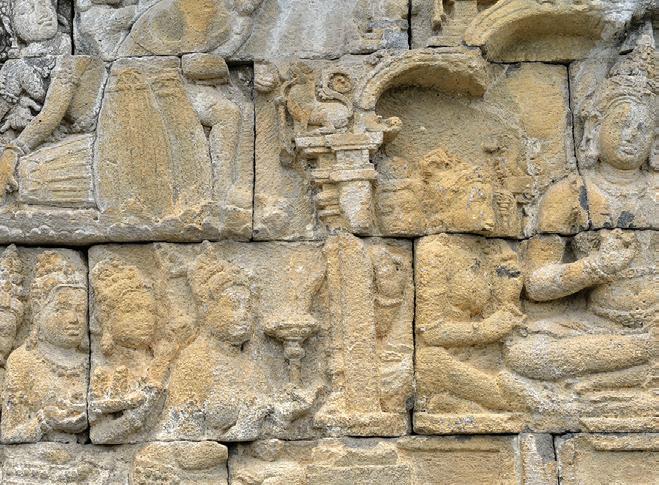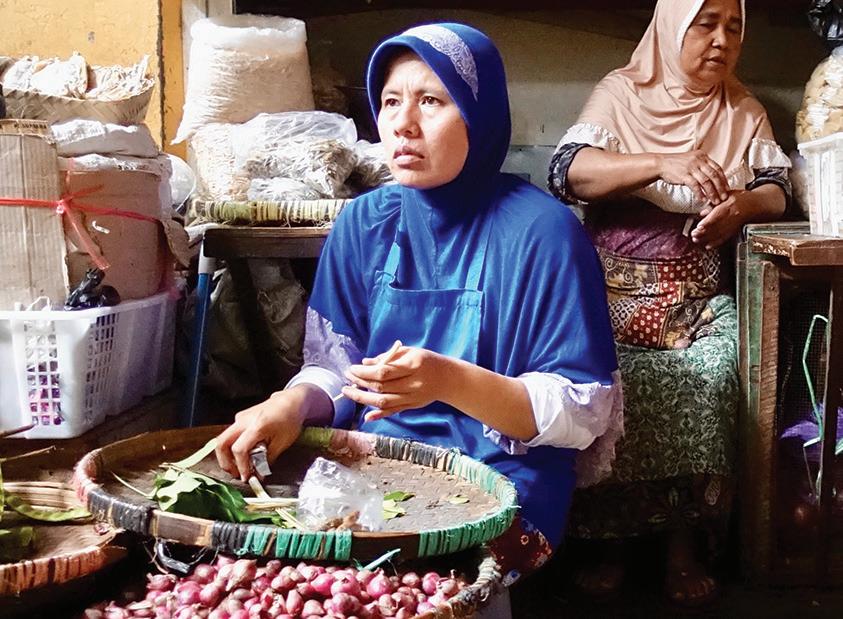
5 minute read
BOROBUDUR
by SMITA and SANJEEV CHANDRA
Our first glimpse of Borobudur took our breath away. Nothing had prepared us for the sheer expanse and grandeur of the largest Buddhist temple in the world as we approached through the park that surrounded it. Situated on a lush plateau on the Indonesian island of Java, the immense pyramid looks like a colossal rock that erupted from the earth. It is easy to understand why local people created legends of a great giant conjuring up the massive structure out of thin air. These myths were born in the centuries when the shrine was abandoned, its origins and purpose forgotten, while the religion it served disappeared from the surrounding lands as Indonesia went from being devoutly Buddhist to a largely Muslim country.
Advertisement
Borobudur was built in the ninth century by the Buddhist Shailendra dynasty that ruled Java at the time. India has had close relations with Southeast Asia throughout history and Indian culture and religions, both Buddhism and Hinduism, were widely adopted across the region. Kings competed to create enormous temple complexes, such as those at Angkor Wat in Cambodia, Bagan in Myanmar and Ayutthaya in Thailand, to display their piety and wealth. Borobudur was designed to rank among the greatest of these.

Borobudur was abandoned in the fourteenth century as eruptions of a nearby volcano forced an evacuation of the surrounding area. At the same time the Javanese population increasingly converted to Islam, a new religion brought by Arab traders and mystics. The temple stones collapsed and were buried under volcanic ash until the nineteenth century when Dutch colonial administrators began to have them unearthed. It was only in 1973 that a massive international effort led to the temple being restored close to its original glory. Today Borobudur is a UNESCO World Heritage Site and Indonesia’s biggest tourist attraction, with millions of visitors each year. It is also an active pilgrimage site where devotees congregate every year to celebrate the Buddhist festival of Vesak.
The temple consists of nine stacked platforms that grow progressively smaller as you ascend. Each terrace has walls covered with stone carvings, interspersed with life-sized statues of the Buddha. The building is designed to take devotees on a spiritual pilgrimage as they walk through its galleries. As we circled each level and then climbed to the next, we were symbolically scaling planes of higher consciousness.
The relief carvings that cover every wall illustrate Buddhist philosophy while simultaneously narrating stories from mythology and episodes from the life of the Buddha. Visitors can follow the Buddha’s quest for enlightenment,

starting with his birth and scenes from his earliest days. As we ascended to the higher levels of the temple, the carvings depicted later stages of the Buddha’s life as he severed all worldly ties and gained greater awareness. The apex of the pyramid, where we emerged into the light, is occupied by an array of Buddha figures, each inside a latticed dome, symbolizing the achievement of nirvana.
The carvings, quite apart from their religious symbolism, are a delightful album of life in ninth century Java. The walls are alive with people feasting, praying, fishing and hunting. Horses and elephants walk in stately processions while queens ride in carriages. Birds perch in the canopy of trees, where every leaf is carved in precise detail, while boars roam under them. Ships battle the waves as sailors cling to their masts.

Borobudur is a short, scenic drive from the bustling city of Yogyakarta on the island of Java, which is where we stayed during our visit. The journey from Yogyakarta to Borobudur is part of the charm of visiting the temple. Some people travel before dawn to catch the sunrise over the pyramid of Borobudur. We chose to leave after sun-up so that we could enjoy the sights along the route. This decision proved well worth it as we stopped many times along the way to take photographs of idyllic rice terraces, gently flowing streams and the lush, mountain fringed countryside.
There is much to see and do in the city of Yogyakarta itself, including sampling their famous street food, visiting local markets or watching a dance performance. Shop here to your heart’s content for handmade batiks, local spices and handicrafts or visit the fresh market, brimming with just picked fruit and vegetables. Indonesia produces some of the finest spices in the world and market stalls overflow with cinnamon, cardamom, cloves and a host of other exotic vegetables and plants.
One of the greatest attractions of traveling in Indonesia is the food. Warungs (family owned roadside eateries) are very popular and a great way to experience local flavors. The food here is always freshly prepared and is never expensive. We sat alongside families of regulars in a shaded veranda overlooking rice fields and enjoyed dishes like sambal grilled fish, sate

babi (pork satay), gado gado (salad with peanut sauce) and lumpia (crisp spring rolls), all served with generous helpings of nasi goreng (fried rice).
In the evening, after our return from Borobudur, we attended an open-air performance of a ballet that recounted tales from the Hindu epic Ramayana using intricate Javanese dance movements accompanied by a gamelan orchestra. The stories have little religious significance for the mostly


Muslim actors and audience, but they are a treasured part of Indonesia’s cultural heritage. For Indian visitors like us it was an intensely moving experience to hear stories that are an integral part of our lives, recounted in such beautiful, exotic surroundings. The moment seemed to capture the essence of Indonesian culture, in which each stratum of history adds a new hue without ever completely erasing the colors of the many layers below, all melding into a beautiful whole.

To book your trip to Borobudur, please contact your Ensemble Travel ®
Group Advisor.













